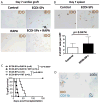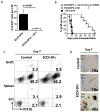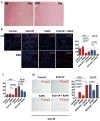Intragraft CD11b(+) IDO(+) cells mediate cardiac allograft tolerance by ECDI-fixed donor splenocyte infusions
- PMID: 22883222
- PMCID: PMC3484208
- DOI: 10.1111/j.1600-6143.2012.04203.x
Intragraft CD11b(+) IDO(+) cells mediate cardiac allograft tolerance by ECDI-fixed donor splenocyte infusions
Abstract
We have previously shown that pre- and post-transplant infusions of donor splenocytes treated with 1-ethyl-3-(3'-dimethylaminopropyl)-carbodiimide (ECDI-SPs) provide permanent donor-specific protection of islet allografts. The efficacy of donor ECDI-SPs in protecting vascularized cardiac allografts and mechanism(s) of protection are unknown. In this study, we show that infusions of ECDI-SPs significantly prolong cardiac allograft survival concomitant with an impressive accumulation of CD11b(+) IDO(+) cells in the cardiac allograft, and that the presence of this population is dependent on Gr1(+) cells. Consequently, depletion of Gr1(+) cells or inhibition of indoleamine 2,3 dioxygenase (IDO) activity abrogates graft protection by ECDI-SPs infusions. In addition, T cells from ECDI-SPs treated recipients secrete high levels of interleukin 10 and interleukin 13 upon in vitro restimulation, which are also dampened in recipients treated with the IDO inhibitor. Furthermore, combination of donor ECDI-SPs with a short course of rapamycin provides indefinite cardiac allograft survival in 100% of the recipients. These findings reveal a novel mechanism of donor ECDI-SPs in inducing cardiac transplant tolerance and provide several targets that are amenable to therapeutic manipulations for tolerance induction for cardiac transplantation.
© Copyright 2012 The American Society of Transplantation and the American Society of Transplant Surgeons.
Conflict of interest statement
The authors of this manuscript have no conflicts of interest to disclose as described by the
Figures






Similar articles
-
Ethylene carbodiimide-fixed donor splenocytes combined with α-1 antitrypsin induce indefinite donor-specific protection to mice cardiac allografts.Transpl Int. 2017 Mar;30(3):305-317. doi: 10.1111/tri.12903. Transpl Int. 2017. PMID: 27957767
-
Ethylenecarbodiimide-fixed donor splenocyte infusions differentially target direct and indirect pathways of allorecognition for induction of transplant tolerance.J Immunol. 2012 Jul 15;189(2):804-12. doi: 10.4049/jimmunol.1103705. Epub 2012 Jun 13. J Immunol. 2012. PMID: 22696445 Free PMC article.
-
Transfusion of ethylene carbodiimide-fixed donor splenocytes prolongs survival of vascularized skin allografts.J Surg Res. 2018 Jan;221:343-352. doi: 10.1016/j.jss.2017.06.005. Epub 2017 Oct 19. J Surg Res. 2018. PMID: 29229149
-
Lung transplantation: chronic allograft dysfunction and establishing immune tolerance.Hum Immunol. 2014 Aug;75(8):887-94. doi: 10.1016/j.humimm.2014.06.015. Epub 2014 Jun 27. Hum Immunol. 2014. PMID: 24979671 Free PMC article. Review.
-
Experimental models of B cell tolerance in transplantation.Semin Immunol. 2012 Apr;24(2):77-85. doi: 10.1016/j.smim.2011.08.018. Epub 2011 Sep 16. Semin Immunol. 2012. PMID: 21925896 Free PMC article. Review.
Cited by
-
Bone marrow-derived AXL tyrosine kinase promotes mitogenic crosstalk and cardiac allograft vasculopathy.J Heart Lung Transplant. 2021 Jun;40(6):435-446. doi: 10.1016/j.healun.2021.03.006. Epub 2021 Mar 13. J Heart Lung Transplant. 2021. PMID: 33846079 Free PMC article.
-
Antigen-specific tolerance in immunotherapy of Th2-associated allergic diseases.Crit Rev Immunol. 2013;33(5):389-414. doi: 10.1615/critrevimmunol.2013007046. Crit Rev Immunol. 2013. PMID: 24099300 Free PMC article. Review.
-
Acute murine cytomegalovirus disrupts established transplantation tolerance and causes recipient allo-sensitization.Am J Transplant. 2021 Feb;21(2):515-524. doi: 10.1111/ajt.16197. Epub 2020 Aug 17. Am J Transplant. 2021. PMID: 32659030 Free PMC article.
-
Impact of infection on transplantation tolerance.Immunol Rev. 2019 Nov;292(1):243-263. doi: 10.1111/imr.12803. Epub 2019 Sep 19. Immunol Rev. 2019. PMID: 31538351 Free PMC article. Review.
-
Murine cytomegalovirus dissemination but not reactivation in donor-positive/recipient-negative allogeneic kidney transplantation can be effectively prevented by transplant immune tolerance.Kidney Int. 2020 Jul;98(1):147-158. doi: 10.1016/j.kint.2020.01.034. Epub 2020 Feb 21. Kidney Int. 2020. PMID: 32471635 Free PMC article.
References
-
- Lechler RI, Sykes M, Thomson AW, Turka LA. Organ transplantation--how much of the promise has been realized? Nat Med. 2005 Jun;11(6):605–13. - PubMed
-
- Dugast AS, Haudebourg T, Coulon F, Heslan M, Haspot F, Poirier N, et al. Myeloid-derived suppressor cells accumulate in kidney allograft tolerance and specifically suppress effector T cell expansion. J Immunol. 2008 Jun 15;180(12):7898–906. - PubMed
Publication types
MeSH terms
Substances
Grants and funding
LinkOut - more resources
Full Text Sources
Other Literature Sources
Medical
Research Materials

